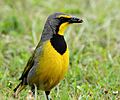Bokmakierie facts for kids
Quick facts for kids Bokmakierie |
|
|---|---|
 |
|
| Conservation status | |
| Scientific classification | |
| Genus: |
Telophorus
|
| Species: |
zeylonus
|
| Synonyms | |
|
|
The bokmakierie (Telophorus zeylonus) is a colorful bird found only in southern Africa. It belongs to a group of birds called bushshrikes. These birds are related to true shrikes, but they are a bit different. You can mostly find bokmakieries in South Africa and Namibia. There's also a small group living in the mountains of eastern Zimbabwe and western Mozambique.
Contents
Discovering the Bokmakierie
The bokmakierie is a special bird that lives in open spaces. You can find it in areas with karoo scrub, fynbos (a type of plant life), and even in parks and gardens in cities.
Building a Home: Bokmakierie Nests
Bokmakieries build their nests in hedges, bushes, or in the fork of a tree. Their nest looks like a bulky cup. A female bokmakierie usually lays two to six eggs, but often it's three. The eggs are greenish-blue with red-brown or lilac spots. Both parent birds take turns sitting on the eggs for about 16 days until they hatch. After hatching, the young birds stay in the nest for another 18 days before they are ready to fly.
What Does a Bokmakierie Look Like?
Bokmakieries are medium-sized birds, about 22–23 centimeters (9 inches) long. They have olive-green feathers on their back and a bright yellow tip on their black tail.
Distinctive Features
Their head is grey, and they have a yellow stripe above their eye, called a supercilium. Their strong beak is hooked on the top. The underside of the bird is bright yellow. They have a wide black band that goes across their throat and chest. This black band continues up the sides of their neck, through their eye, and towards their beak. Their legs and feet are blue-grey.
Male and female bokmakieries look very similar. However, young bokmakieries are a dull grey-green on their underside and do not have the black band.
Different Kinds of Bokmakieries
There are four different types, or subspecies, of bokmakieries. They mainly differ in their color shade and size. Most bokmakieries are not in danger of disappearing. However, one special dark subspecies, called restrictus, lives only in the Chimanimani Mountains. There are only about 400 of these birds left.
The Bokmakierie's Song
Bokmakieries are known for their loud whistles and calls. Often, a pair of birds will sing together, taking turns in a duet. The most common call sounds like "bok-bok-mak-kik," which is how the bird got its name! A famous explorer named François Levaillant first wrote about this bird and called it bacbakiri because of its call. Later, Dutch settlers in the area called it bokmakierie.
Bokmakierie Behavior and Diet
Unlike some shrikes that sit out in the open, the bokmakierie is quite shy and likes to stay hidden. This bird eats a typical shrike diet, which includes insects, small lizards, small snakes, tiny birds, and frogs.
Who Hunts the Bokmakierie?
Bokmakieries can be hunted by other animals. Their predators include snakes, mongooses, and larger shrikes like the northern fiscal and southern boubou.
Images for kids
-
A bokmakierie in the southern KwaZulu-Natal Drakensberg mountains.



